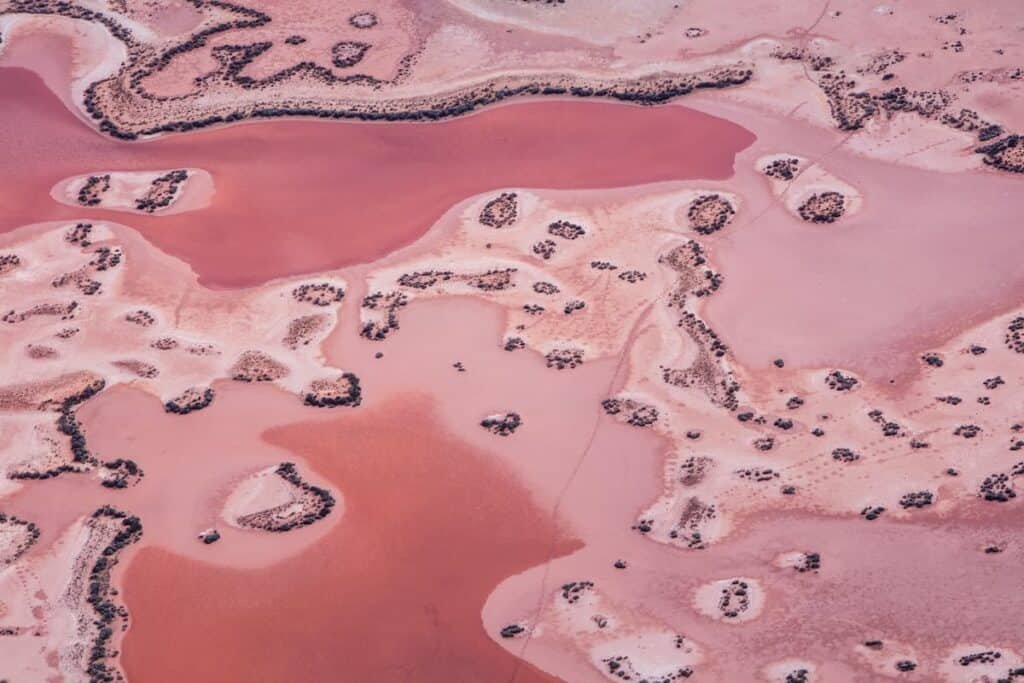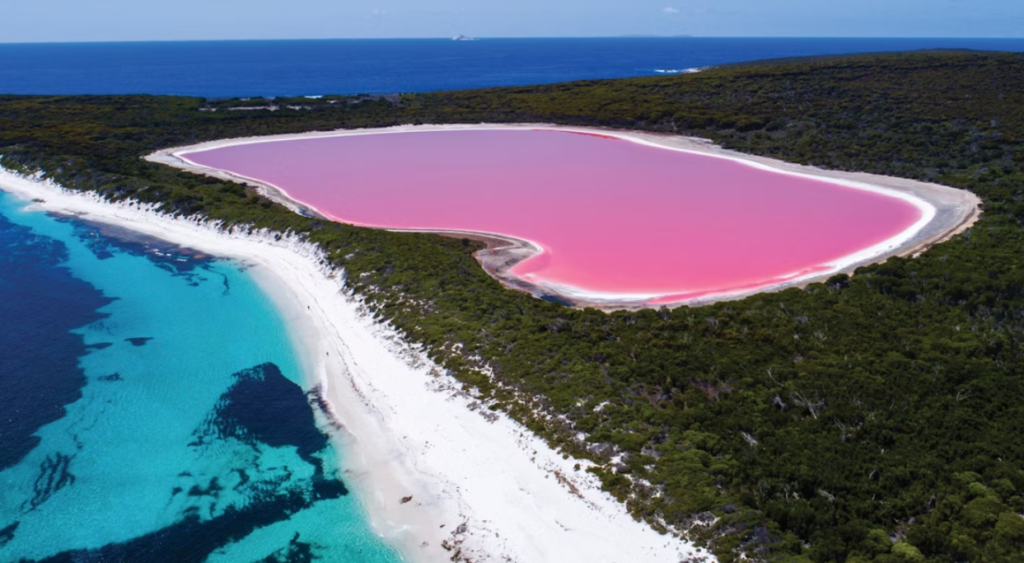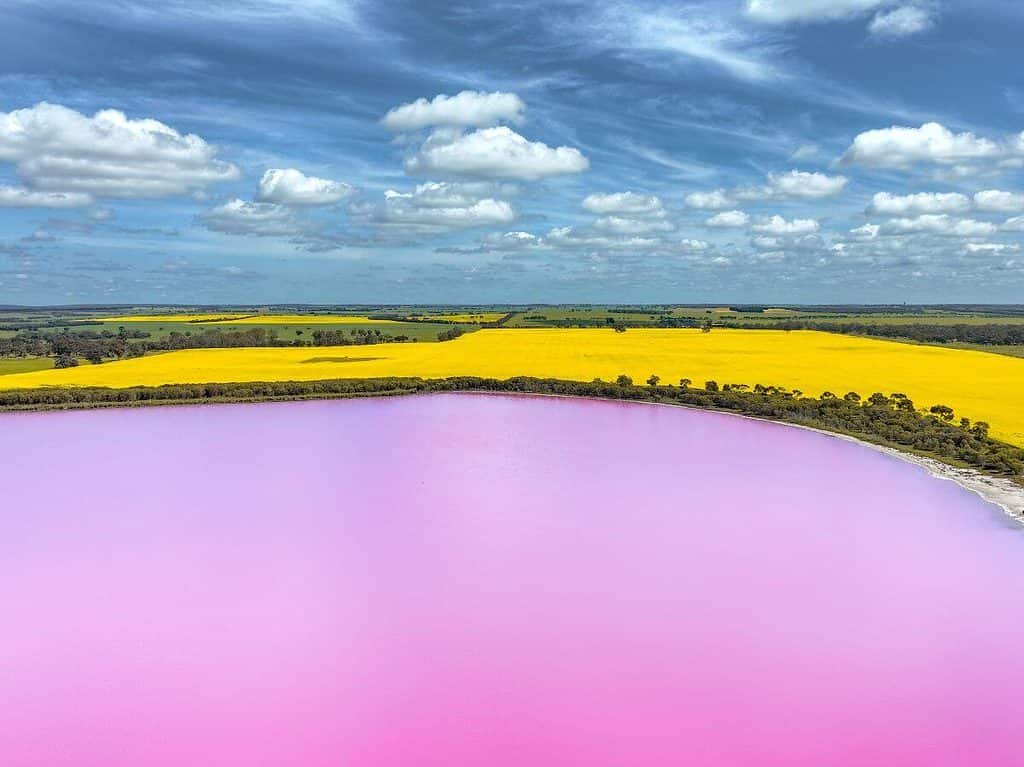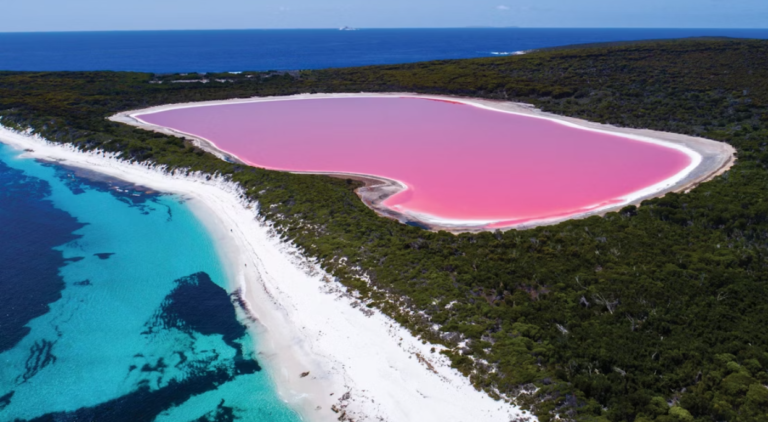Australia is home to many natural wonders and wilderness. One of these stunning landmarks is the Pink Lakes, which are truly a sight to behold and Instagram-worthy. The Pink Lakes of Australia are famous for their vibrant shades of pastel pink to fuchsia, which can be found in different locations as mentioned in the article for your next Pink Lakes adventures in Australia.
In this blogpost we’ll also explore the natural phenomenon behind the lakes ‘pink color, where to find them and what makes them so fascinating.
What Causes the Pink Color in Australian Lakes?

The rare pink hues of these lakes are caused by a combination of environmental and biological factors. The main catalyst is the algae called “Dunaliella salina,” which thrives in a saline, high-alkaline environment. Basically, these algae produce a red pigment called “beta-carotene,” which causes the water to retain a distinctive pink or faint reddish tint.
The salinity of these lakes is typically very high, and they often have little to no outflow, causing the water to become highly concentrated. These conditions, along with the warm, sunny climate, create a perfect habitat for “Dunaliella salina” and other microorganisms like “halophilic bacteria,” which also contribute to the pink color.
Key Factors for Pink Lake Formation
- High salinity levels: Pink lakes are often present in areas where evaporation exceeds rainfall.
- Alkaline water: Many of these lakes have a high pH, providing a favorable environment for algae.
- Warm temperatures: Heat intensifies the coloration, especially during the summer months.
- Microorganisms: Algae and bacteria produce pigments that turn the water pink.
Top 5 Pink Lakes in Australia
Lake Hillier, Western Australia (WA)

Lake Hillier deserves to be at the top of the list because it is the most famous pink lake in Australia. It is located on Middle Island, which is part of the Recherché Archipelago, a region in Western Australia.
The bubble gum pink colored water remains the same throughout the year, captivating visitors with its stunning views. The color is so vibrant that it and so intriguing particularly from the air. It makes it a favorite for aerial photography.
The lake’s pink hue is particularly vivid when viewed from a distance, and despite its location on a remote island, it’s accessible by boat or small aircraft.
Visitors are often left in awe of the lake’s surreal appearance, and while it’s not recommended to swim in it, you can enjoy the view from a nearby observation point.
Hutt Lagoon, Western Australia

Hutt Lagoon is located in the Coral Coast near the town of Port Gregory. It is one of the most visually stunning lakes. It has a rather deep pink color due to the high concentration of algae. The views are spectacular during sunset and sunrise when the cloudy skies harmonize with the gorgeous pink waters.
The lake is accessible by road and is famous for its iconic location next to a seafood farm, where the salt from the lake is harvested.
Travelers to this region can enjoy not only the beauty of the lake but also a range of other activities, including exploring the nearby “Kalbarri National Park” and the “Coral Coast’s” own stunning beaches.
Lake Eyre, South Australia (SA)

Lake Eyre, also known as Kati Thanda-Lake Eyre. It is the largest Salt Lake located in the heart of the outback, Australia. It may turn pink during certain times of the year.
While it is often dry, when it fills with water after rare rainfalls, the conditions become ideal for the growth of microorganisms, the main factor of the pink tint.
It offers beautiful sights when filled with water, although it’s a more intermittent experience than other lakes on this list. The surrounding desert landscape.
Lake MacDonnell, South Australia

Lake MacDonnell is located near the town of Penong on the Eyre Peninsula. This lake is often well-known for its intense pink and lavender colors. The lake’s color can vary depending on the time of year and the amount of water present, but it is most vibrant during the warmer months.
Easily accessible by car and surrounded by rugged landscape and sand dunes, it’s undeniably a visual feast for tourists.
Dimboola Lake, Victoria
Pink Lake is located near the town of Dimboola in Victoria. Although it’s not as popular as the other lakes mentioned above. It is still worthy to include in the list of places to visit.

The lake’s color is most prominent during the summer months, especially after long dry spells that increase the salinity of the water. This is one of the primary reasons that cause the phenomenon of pink hues in the lake, as discussed.
One of the advantages of visiting this lake is that, unlike other pink lakes, this is more accessible as compared to others. Therefore, it is an easy stop for tourists, especially for those exploring the Grampians or Wimmera region.
It is relatively close to other natural attractions in the area, namely the Grampians National Park (about 2.5 hours’ drive away). Dimboola Wetlands, Lake Wartook, Little Desert National Park, Hall’s Gap, Natimuk, Ararat, Murray-Sunset National Park, and Swan Hill.
Best Time to Visit the Pink Lakes of Australia
The best timeframe to visit these lakes would be during the warmer months, i.e. September to November. When there’s spring or when the temperature is a bit higher, i.e. December to February. The reason being that the high-water temperature of the lake causes increased evaporation which gives rise to a higher salt concentration. In return, intensifies the pink color.
Nevertheless, it’s important to know that not all pink lakes maintain their pink hues all year round. On the flipside, Lake Eyre only turns pink when there is enough rainfall, and when there is water in the lake. The Lake Hillier, on the contrary, retains its vibrant colors permanently. That is why it is more popular among tourists.
Tips for Visiting Pink Lakes of Australia
- As many of these lakes are located in remote areas. Always check the accessibility and weather forecast before planning your visit.
- During your visit, refrain from activities that are harmful to the ecosystem. Also, always check if swimming is allowed or not, as some lakes, like Lake Hillier, forbid swimming.
- Get your best photo shoots using various modes of photography. The golden hour upon these lakes is a wonderful experience, so keep that in mind while planning your trip.
- Pack light and bring all the travel essentials, especially the sunscreen.


